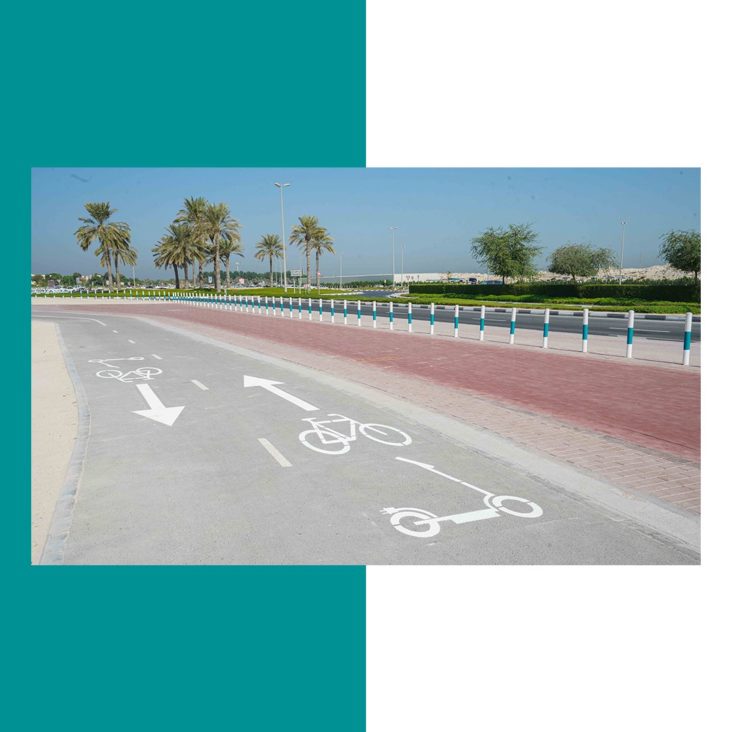RTA Operates E-Scooters In 10 Dubai Districts From Q1 2022

The Roads and Transport Authority (RTA) announced the start of civil site works for the infrastructure of the operation of the Electric Scooter in preparation for the launch of Phase I of the project, which would cover 10 Dubai districts and start operation in the first quarter of 2022.
The step responds to the Executive Council’s endorsement of the shared mobility plan and the supporting e-scooter policy. It culminates the huge success of the trial run phase of the e-scooter, which started in October 2020 in 5 key areas of Dubai. Until the end of September, e-scooters have made about half a million trips. RTA plans to expand the use and tracks of e-scooters to include specific residential areas, and 23 new districts later on.
“The initial phase covers Sheikh Mohammed bin Rashid Boulevard, Jumeirah Lakes Towers, Dubai Internet City, Al Rigga, 2nd of December Street (specified track and zone), The Palm Jumeirah, and City Walk. It also covered safe roads in Al Qusais, Al Mankhool, and Al Karama communities as well as cycling tracks except for the cycling tracks of Seih Al Salam, Al Qudra, and Meydan,” said Mattar Mohammed Al Tayer, Director-General, Chairman of the Board of Executive Directors of the RTA.
“The selection of these districts was guided by specific criteria, such as high population density, special development areas, areas served by metro stations and mass transportation, the availability of integrated infrastructure, and areas with a high level of traffic safety.
“The operation of the e-scooter is part of Dubai Government’s efforts to improve the quality of life and make residents happier, shift towards sustainable transport and make Dubai the preferred place to live and work as well as the preferred and the safest destination for visitors. RTA calls for adopting a healthy and active lifestyle through providing for an integrated and efficient transportation network in the Emirate. It also seeks to provide multiple transportation options for users, in accordance with top international practices that place Dubai among the leading countries in this field,” explained Al Tayer.
“The trial operation of the e-scooter proved successful as a suitable means for individual commuting over short distances and first and last-mile trips. The customers’ satisfaction rating of the experiment reached 82%. RTA, in coordination with Dubai Police, examined several international models and experiences of major cities in operating e-scooters, such that it can choose the most appropriate model for Dubai,” noted Al Tayer.
“RTA also conducted many benchmarking studies of e-scooter operations with a variety of international cities such as London, Paris, New York, Berlin, and Singapore. We have identified the key elements of streamlining the operation of shared and personalised E-Scooters. Such studies were based on four main aspects: the user, the electric scooter, the road and the business model with the operating companies,” he commented.
RTA called on the public to avoid using electric scooters on tracks that are still under construction to avoid mishaps. Infrastructure works for e-scooters in new districts is proceeding according to plan. Works are nearing completion in the placement of traffic and directional signs for e-scooters at the best international specifications and standards of traffic safety.
Over the past months, RTA conducted technical studies and user surveys to screen the views of service users and their observations for the project improvement. Periodic meetings were held with Dubai Police and operating companies. Field visits were carried out to verify the work in the new area to ensure their readiness before opening them for e-scooter users. RTA also unleashed several initiatives to encourage road users to use e-scooters, as they are environmentally friendly and suitable for short trips and first and last-mile trips that facilitate access to and from mass transit stations.
The e-scooter is permitted to operate under strict guidelines and designated tracks. The rider and the renter must comply with the rules and regulations set by RTA, which are aligned with the traffic rules law. They govern the use of e-scooters and the associated traffic safety stipulations such as the wearing of the protective helmet. The e-scooter must be parked at designated places and must not be left in places that trigger traffic bottlenecks. Riders must ride cautiously and avoid causing traffic risks to other road users. They must comply with all instructions and regulations relating to the areas where e-scooter riding is permitted, as mentioned in the apps designed for operators.


